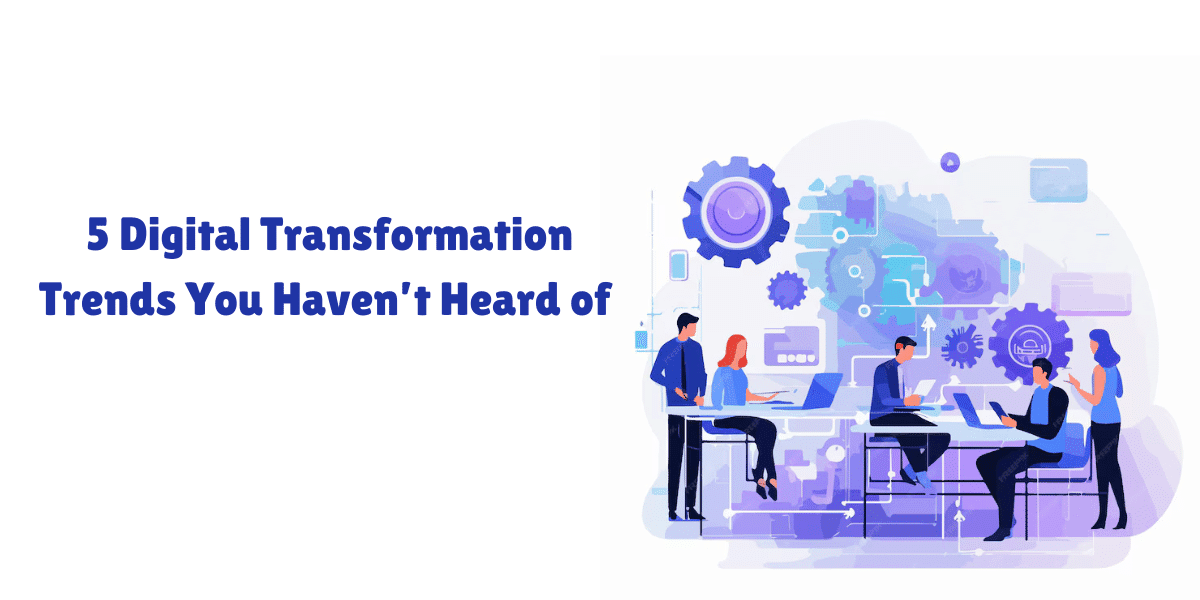Let me tell you something interesting. How would you react if I told you that digital transformation is no longer an alien term in the diverse industrial domain? I think many of you may get confused because you might have heard about digital transformation services but still not implemented that into your existing business processes. Well, the reason is obvious.
Many business entrepreneurs are hesitant to integrate digital transformation because they assume that it’s a complicated process that may require them to hire expert digital transformation service providers, which of course will lead to additional expenditure and disrupt their budget plans.
On the other hand, many business owners and CEOs start thinking of transformative technologies like artificial intelligence, machine learning, the Internet of Things, blockchain, cloud computing, and more when they come across the term digital transformation. There is nothing wrong with this thought as all these innovative technologies are an integral part of digital transformation consulting services.
However, keeping all these discussions aside we can say one thing with complete certainty digital transformation services are revolutionizing how businesses operate, engage with customers, and generate value. We can understand this fact from a Gartner insight that states that 91% of businesses have incorporated digital transformation into their practices in some format, while 87% of business leaders think digitalization is a priority.
Well, this is going to be an interesting and informative article for you as we are here to primarily discuss and highlight five digital transformation trends you probably haven’t heard of. But we suggest that you keep them on your radar and good books so that you can implement them when required and necessary.
1. The Innovative Combination of Digital Twin and Metaverse
Digital Twins, as you know are virtual replicas of physical assets or processors has been around for quite some time. They are extensively used in diverse industry verticals, such as manufacturing, aviation, automotive, and energy and utilities. They help business organizations to simulate and monitor real-world systems in real time, providing critical data for optimization and maintenance.
However, do you know what happens when digital twins merge with another trailblazing trend — the Metaverse? You can create a more immersive experience for customers with 3D stimulations that integrate with CAD software and other technologies. And this is the reason why Tech Titans like Microsoft and Meta have partnered together and are investing in Metaverse technology heavily.
The best example that we can put forward here is that of a smart city that uses Metavverse technology to create the necessary infrastructure. Also, engineers, planners, and policy-makers can walk through virtual streets — the magical impact of digital twin and metaverse alignment.
2. Edge Intelligence: Smarter, Faster, More Independent Devices

You must have heard about edge computing, which is of late making a lot of headlines in the software development and IT solutions industry. It is an advanced and sophisticated method of bringing data closer to the source or on the edge of the network. But here’s a twist in the tale.
Do not confuse Edge Intelligence with Edge Computing as these two are two different technologies. To be precise, edge intelligence is an evolutionary term that refers to the ability of edge devices to not just process data but make real-time decisions based on AI and machine learning algorithms without relying on cloud services.
For instance, self-driving cars would be able to respond in a split second and even avoid the possibility of accidents without transferring the information to the cloud server and waiting for a response. In manufacturing, smart sensors mounted on the floors of the factories would detect defects or faults and correct them automatically. Edge intelligence will significantly improve performance in environments requiring decisions to be made in real-time by eliminating delay and allowing devices to make autonomous decisions.
3. Hyper-Personalization Through Generative AI
Although personalization through AI is not a new phenomenon, the second wave of innovation will be more based on applying generative AI to customer experience strategies. Generative AI systems, like OpenAI’s GPT-4, can create new content, designs, or even product ideas from scratch. This technology will come in handy for businesses to offer hyper-personalized services more than what they can do by just analyzing behavior and making recommendations about the product.
We can take the example of eCommerce platforms like Amazon and eBay that are using AI-powered recommender systems to send personalized product suggestions to customers. This is based on their choices, browsing patterns, and even psychographic profiles.
4. Quantum-Safe Cryptography

Digital transformation services are getting another boost with the advent of quantum computers, there is growing concern that the present methods of encryption, widely used today, including RSA and elliptic-curve cryptography, are not safe. These methods were based on problems devised to be so intractably complex that no known computer could solve them in a realistic number of years. Quantum computers would theoretically solve some of those within minutes and send previously protected financial transactions, healthcare records, and government communications into the wild.
Enter quantum-safe cryptography: This new field of cryptography is working to develop new algorithms that are said to be resistant to quantum attacks from their very nature. As quantum computers are getting so strong that they could break the present encryption systems, these algorithms are functioning towards making it possible for the system to permit data security in all these changes. Some organizations, especially those related to finance, defense, and healthcare, are now testing whether there exist quantum-safe systems of cryptographic.
5. Digital Ethics and Autonomous Governance
The demand for digital ethics frameworks and autonomous governance systems is rising in alignment with the business processes of organizations by the increasing AI and automation. After all, AI is making all decisions from healthcare to Fintech and, therefore, businesses are under tremendous pressure to ensure that these technologies act ethically and transparently.
The latest trend used to monitor and audit decision-making in real-time is autonomous governance systems employing AI. These systems rely on pre-defined ethical guidelines, legal frames of reference, and best practices to ensure that an organization’s AI is aligned with the organization’s values and societal expectations.
For example, a bank using AI at the frontline in loan approvals would implement autonomous governance to ensure that the AI indeed makes decisions based on criteria unbiased free in an objective manner, and line with principles governing financial regulations. In healthcare, for example, AI-assisted diagnosis can be audited to ensure no unintentional damage through misinterpretations or biases of data being used.
Why Does These Digital Transformation Trends Matter?

- Merging the metaverse with digital twins offers more immersive and interactive environments for industries that rely heavily on large-scale simulation.
- Edge intelligence is a game-changer for sectors like manufacturing, logistics, and autonomous systems (drones, vehicles) where real-time decision-making is crucial.
- Generative AI takes personalization to an entirely new level, offering custom content, products, and experiences that feel tailor-made for each user.
- Quantum-safe cryptography will be crucial for industries that rely on the long-term protection of sensitive data, from finance to healthcare to government.
- Autonomous governance frameworks will be essential for maintaining trust in AI-driven systems, ensuring they operate within legal and moral boundaries.
Conclusion
The digital world continues to evolve, and even as we see the hype of some technologies, like cloud computing, AI, and blockchain, emerge into our headlines, there are so many emerging trends quietly but profoundly changing industries. From the immersive capabilities that digital twins would allow in the metaverse to how security-driven innovation powers quantum-safe cryptography, these trends will help define the next decade of digital disruption.
Indeed, doing that will make businesses explore the lesser-known digital transformation trends to remain agile in an ever-changing environment. More importantly, however, it will prepare businesses as best as possible to face future problems when they come. Keep an eye on these new developments-you may just find this is the secret to your next big break.
About Author: Niraj Jagwani is an engineer by degree and a CEO by profession, who has co-founded several businesses in the domain of digital transformation services. He has successfully helped clients across multiple industries increase revenues, optimise processes, and achieve new milestones. He also has a knack for writing and loves to share his ideas and knowledge on everything technology, software systems, and the latest industry trends.



How to Turn Your Blog Into a Money-Making Machine (Even If You’re Just Starting)
How to Set Role-Based Pricing in WooCommerce (Wholesale & Retail)